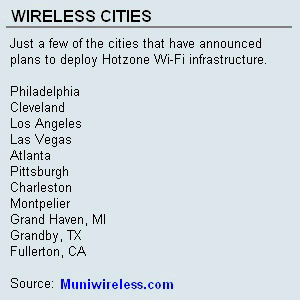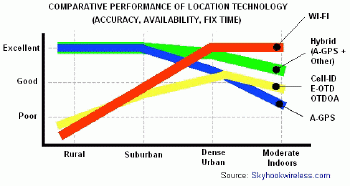 During the past several months alone, dozens of cities began to implement
low-cost or even free Wi-Fi Internet
access in entire cities.These projects, known as "hotzones," enjoy
widespread support from
both
the business and private sector.Economic
proponents
claim that these projects expand commerce
and will
attract new business, while many community
advocates
argue that wireless broadband should be seen as
a fundamental right that can help
to level the technological playing
field.All agree that wireless access will be a
fundamental means for public communication in the near future.
During the past several months alone, dozens of cities began to implement
low-cost or even free Wi-Fi Internet
access in entire cities.These projects, known as "hotzones," enjoy
widespread support from
both
the business and private sector.Economic
proponents
claim that these projects expand commerce
and will
attract new business, while many community
advocates
argue that wireless broadband should be seen as
a fundamental right that can help
to level the technological playing
field.All agree that wireless access will be a
fundamental means for public communication in the near future.
In most cities the incumbent carriers and government are cooperating.In New York, for example, carriers have partnered with the city to deploy Wi-Fi access points on city-owned traffic lights, facilitating low-cost broadband in underserved areas of the city.In other places, however, there has been a distinct lack of cooperation. One recent flap in Philadelphia demonstrates how the incumbent telecommunication companies view the hotzone trend as a threat. In September, Mayor John Street announced plans to make Philadelphia a "Hot City".Identifying the city government as a potential competitor, Verizon Communications immediately launched a well-funded lobbying effort, seeking to prohibit the plan.The state legislature began the process to pass a bill that would prohibit all municipalities in Pennsylvania from becoming broadband service providers.This threatened the mayor's project, but the negative publicity and public pressure that ensued forced an agreement that allows the Philadelphia project to move forward - albeit with a restricted scope.
Regardless of who wins the battle to provide this technology, it is clear that the growth and distribution of Wi-Fi is accelerating. This is largely the result of two essential characteristics of Wi-Fi -- speed and interoperability (e.g.standards). The Starbucks crowd and the business traveler want mobile access to data intensive applications and services.Email, VOIP, CRM and quality picture messaging require throughput that 3G is currently unable to support.These proprietary wireless networks saddle users with "application fees" to run CRM or email programs on their devices.To contrast this, Wi-Fi's interoperability and openness encourages innovation and development, in addition Wi-Fi offers at least an "order of magnitude" more bandwidth.This is expanding business opportunities.
When attempting to predict where these opportunities may arise, it is instructive to look at university campuses.Many universities have been Wi-Fi enabled for years and over the course of that time have developed technology and applications that take advantage of wireless infrastructure.At Dartmouth and UCSD, students benefit from free telecommunications, collaborative study spaces, location based games, virtual message boards, campus tours, and friend-finders.The users in these "closed environments" have become accustomed to, and reliant upon, the advantages and convenience that pervasive Wi-Fi brings.As the hotzone trend expands, many of these applications will move out of the campus environment and into the mainstream. One need only look at the success of Skype (50 million downloads) to understand that these applications will re-make the telecommunications industry.
One area that will be significantly affected by pervasive Wi-Fi is the market for global positioning and location services.For the last several years, growth of location based services has been hindered by the shortcomings of existing positioning technology and its relatively low levels of penetration.GPS, for example, does not work indoors, struggles in downtown areas, and is expensive.Cell tower triangulation is notoriously inaccurate and, like GPS, requires specialized hardware in contrast to Wi-Fi devices which are inexpensive and multipurpose.Municipalities that want to track their utility or emergency service vehicles are finding that Wi-Fi positioning can be a more cost effective and accurate alternative.Companies that provide mapping, asset tracking & recovery, location based gaming, or local search and advertising applications are beginning to leverage Wi-Fi and the "hot zone" infrastructure to add new location capabilities to these applications. This will greatly speed the deployment of location based services, and significantly expand the number of devices that can support these applications.
As with other technological "revolutions" the move to wireless broadband will create winners and losers.While it is too early to determine who the winners will be, it is clear that the emergence of Wi-Fi technology will profoundly alter how we access and exchange information and more importantly how we interact with the world around us.
